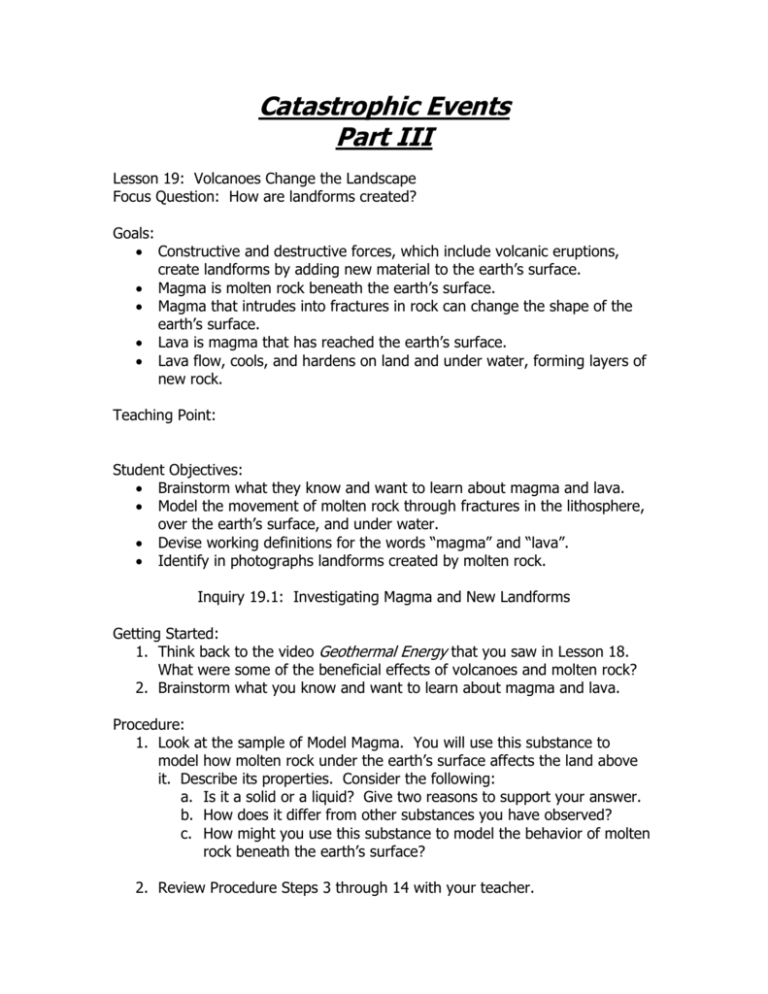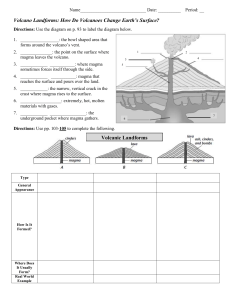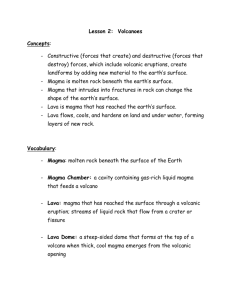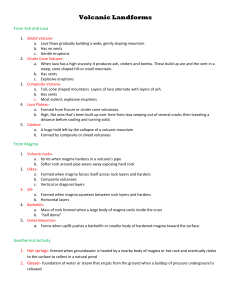Catastrophic Events
advertisement

Catastrophic Events Part III Lesson 19: Volcanoes Change the Landscape Focus Question: How are landforms created? Goals: Constructive and destructive forces, which include volcanic eruptions, create landforms by adding new material to the earth’s surface. Magma is molten rock beneath the earth’s surface. Magma that intrudes into fractures in rock can change the shape of the earth’s surface. Lava is magma that has reached the earth’s surface. Lava flow, cools, and hardens on land and under water, forming layers of new rock. Teaching Point: Student Objectives: Brainstorm what they know and want to learn about magma and lava. Model the movement of molten rock through fractures in the lithosphere, over the earth’s surface, and under water. Devise working definitions for the words “magma” and “lava”. Identify in photographs landforms created by molten rock. Inquiry 19.1: Investigating Magma and New Landforms Getting Started: 1. Think back to the video Geothermal Energy that you saw in Lesson 18. What were some of the beneficial effects of volcanoes and molten rock? 2. Brainstorm what you know and want to learn about magma and lava. Procedure: 1. Look at the sample of Model Magma. You will use this substance to model how molten rock under the earth’s surface affects the land above it. Describe its properties. Consider the following: a. Is it a solid or a liquid? Give two reasons to support your answer. b. How does it differ from other substances you have observed? c. How might you use this substance to model the behavior of molten rock beneath the earth’s surface? 2. Review Procedure Steps 3 through 14 with your teacher. 3. Review the Safety Tips with your teacher. 4. Decide how you might organize your observations in a table. Design the table. 5. Collect your plastic box of materials. 6. Observe the Model magma again. Record your observations of the Model Magma in your observation table. Make a prediction about what might happen to the substance when it is heated. Discuss this with your group. Return the Model Magma to its container. 7. Make certain the soil is firmly pressed into each container. If it is not, pack it down with the spoon. You will use this soil to model land on the earth. 8. Working inside the plastic box at all times, very gently place a container of soil into the container of Model Magma, as shown in Figure 19.1. Then hold the container in both hands. Slowly press down on the container of soil. Press down for only a few seconds. Then stop! What do you observe? Record your observations on your table. You can use both words and pictures. 9. Again working very slowly, push the container of soil farther down into the container of Model Magma, until you cannot press down any more. Discuss your observations with your group. Record them on your observation table. Then set aside the stacked Model Magma and soil. 10. Have one member of your group collect from your teacher the hot Model Magma. Fill your empty plastic container (the one with no hole) about three-fourths full. 11. Stir the heated Model Magma with the spoon. Do not touch the magma with your hands. It is hot. How is the heated Model Magma different from the room-temperature Model Magma? Record your general observations of it in your observation table. How do you think the heated Model Magma will behave under the soil? Discuss this with your group. 12. Repeat Procedure Steps 8 and 9 using the heated Model Magma and a new container of soil. Discuss your observations with your group after each step. Record your findings in your observation table. 13. Slowly lift the container of soil out of the container of heated Model Magma, as shown in Figure 19.3. Hold the soil container above the container of magma. Observe what happens to the magma and soil. Record your observations. 14. Clean up by following your teacher’s instructions. Reflecting on What You’ve Done: 1. Answer these questions: a. Were there any signs in the soil that magma was moving under the ground? b. How does rising magma affect land with no hard rock above it? c. What happened when the room-temperature Model Magma reached the surface of the soil? d. How did the flow of the room-temperature Model Magma differ from the flow of the heated Model Magma? e. What happened to the soil when you drained the heated magma from it? 2. Use your own observations in the lab to develop working definitions for the words “magma” and “lava.” Record your observations in your notebook. 3. Think about what happened to the soil when the Model Magma moved under it. Then answer these questions: a. Why do you think an earthquake almost always happens before lava erupts onto the land? b. What are some of the signs that help Volcanologists predict a volcanic eruption? 4. Apply what you observed in this inquiry to magma and lava on the earth. Look at the illustration and photographs in Figures 19.4 through 19.8. Read the captions. For each figure, describe what you did during Inquiry 19.1 that helped you better understand how each landform was made. Inquiry 19.2: Investigating Lava and New Landforms Getting Started: 1. Why and how do you think rock melts? Share your ideas with the class. 2. Collect your plastic box of materials. Remove the block of wax and the hand lenses. Examine the wax. What are its properties? For example, what are its color, size, shape, and odor? 3. Share your observations about the wax. 4. Make a prediction. What do you think would happen if you heated the wax? 5. Look at the heated wax that your teacher shows you. What are its properties now? How are they the same as the properties of the solid wax? How are they different? Like the solid wax, solid rock will also melt, but at much higher temperature. In this inquiry, you will use melted waxt to model lava flow on land and in water. Procedure: 1. Review Procedures Steps 3 through 10 with your teacher. Discuss how you will record your observations in an organized way. 2. Before you begin the inquiry, review the Safety Tips with the class. 3. Remove the remaining materials from the plastic box. You will also need the lid from the plastic box for this inquiry. You will collect the containers of melted wax and beaker of cold water from your teacher in later steps. 4. Create a slope using the lid from your plastic box. Cover the slope with waxed paper, as shown in Figure 19.9. The waxed paper should extend past the lid and flatten out on the table, as shown. (Use your piece of tape if the waxed paper will not stay in place on the lid.) 5. Discuss with your group how you think melted wax will change when you pour it onto the flat part of the waxed paper. Predict how the melted wax will behave when you pour it onto the sloping part of the waxed paper. 6. Collect one container of melted wax from your teacher. Test your predictions by doing the following: a. Pour one-fourth of the container of hot wax onto the flat waxed paper. Notice how the melted wax behaves. b. Pour one-fourth of the container of hot wax onto the sloping part of the waxed paper, as shown in Figure 19.10. Discuss your observations with your group. c. Wait 5-10 seconds. Then pour another one-fourth of the hot wax onto the same area of the sloping waxed paper. Wait again. Then pour the final one-fourth of the hot wax onto the same sloping area of the waxed paper. Discuss your observations with your group. Record them in your observation table. d. Use a hand lens to look carefully at the wax. What is its texture? What is its appearance? Is it a solid or a liquid? Record your observations in your notebook. 7. Now get a second container of heated wax while another member of your group gets 200 mL of very cold water from your teacher. 8. What do you think will happen when the melted wax flows into cold water? Discuss your predictions with your group. 9. Test your predictions. Kneel down so that you are at eye level with the beaker. Place an index card behind the beaker so you can see clearly. Quickly pour the entire container of h ot wax into the beaker of cold water. Do not touch the wax for several minutes. Record your observations. After several minutes, remove the wax from the water. Turn it upright. Draw a picture of what happened to the “undersea lava.” 10. Clean up by following these steps: a. Return any solid wax to your teacher. b. Pour out the water in your beaker. Reflecting on What You’ve Done: 1. Answer the following Questions: a. Describe the movement of the melted wax on the slope. How did that movement differ from the movement on the flat part of the waxed paper? b. Describe the texture of the cooled wax. c. How did the behavior of the cooling wax on the waxed paper compare with its behavior in the water? 2. Apply what you observed in this inquiry to cooling lava on the earth by answering these questions. a. How do you think lava forms rock? b. How do you think volcanic mountains (such as Mt. St. Helens) and volcanic islands (such as Hawaii and Iceland) form? c. Under what circumstances do you think lava flows into the ocean? d. What happens to lava when it flows into the ocean or erupts onto the ocean floor? 3. Look at the photographs in Figures 19.11 and 19.12. Read the captions. For each one, describe what you did during Inquiry 19.2 that helped you better understand how each landform was created. Record your ideas in your notebook. 4. Look ahead to the next lesson, in which you will examine how lava can form different sizes and shapes of volcanoes.








